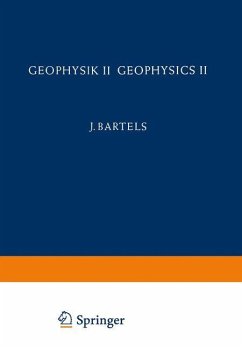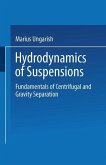Geophysik II / Geophysics II
Herausgegeben:Bartels, Julius
Geophysik II / Geophysics II
Herausgegeben:Bartels, Julius
- Broschiertes Buch
- Merkliste
- Auf die Merkliste
- Bewerten Bewerten
- Teilen
- Produkt teilen
- Produkterinnerung
- Produkterinnerung
45 downwards because (j on the average increases with height; but this conclusion does not follow from (18.3) when the dependency of Kc upon ~o is taken into consideration. s 2 ERTELl and PRIESTLEY and SWINBANK have shown that the upward eddy flux of sensible heat must be larger than indicated by (18.3), because this formula does not account for the fact that rising eddies are systematically warmer than sinking eddies because of the effect of buoyancy. The reader is referred to the reviews by SUTTON [22], [23] and PRIESTLEY and SHEP PARD [15) for further details concerning eddy-flux of heat…mehr
Andere Kunden interessierten sich auch für
![Fundamentals of Geophysical Hydrodynamics Fundamentals of Geophysical Hydrodynamics]() Felix V. DolzhanskyFundamentals of Geophysical Hydrodynamics74,99 €
Felix V. DolzhanskyFundamentals of Geophysical Hydrodynamics74,99 €![Present and Future of the Cosmic Microwave Background Present and Future of the Cosmic Microwave Background]() Present and Future of the Cosmic Microwave Background37,99 €
Present and Future of the Cosmic Microwave Background37,99 €![Vortex Structure and Dynamics Vortex Structure and Dynamics]() Vortex Structure and Dynamics74,99 €
Vortex Structure and Dynamics74,99 €![Fluid Flow Through Porous Macromolecular Systems Fluid Flow Through Porous Macromolecular Systems]() F. W. WiegelFluid Flow Through Porous Macromolecular Systems40,99 €
F. W. WiegelFluid Flow Through Porous Macromolecular Systems40,99 €![Hydrodynamics of Suspensions Hydrodynamics of Suspensions]() Marius UngarishHydrodynamics of Suspensions74,99 €
Marius UngarishHydrodynamics of Suspensions74,99 €![Vortex Rings Vortex Rings]() D. G. AkhmetovVortex Rings74,99 €
D. G. AkhmetovVortex Rings74,99 €![Sciences of Geodesy - II Sciences of Geodesy - II]() Sciences of Geodesy - II110,99 €
Sciences of Geodesy - II110,99 €-
-
-
45 downwards because (j on the average increases with height; but this conclusion does not follow from (18.3) when the dependency of Kc upon ~o is taken into consideration. s 2 ERTELl and PRIESTLEY and SWINBANK have shown that the upward eddy flux of sensible heat must be larger than indicated by (18.3), because this formula does not account for the fact that rising eddies are systematically warmer than sinking eddies because of the effect of buoyancy. The reader is referred to the reviews by SUTTON [22], [23] and PRIESTLEY and SHEP PARD [15) for further details concerning eddy-flux of heat and turbulent diffusion. 19. RICHARDSON'S criterion. The right-hand side of (15.10) represents the rate of production of eddy energy. The last term represents energy loss by dissipation; in order that the eddy energy shall be maintained, it is therefore necessary that P div V" - (! V" v" . grad. v > O.
Produktdetails
- Produktdetails
- Handbuch der Physik Encyclopedia of Physics 10 / 48
- Verlag: Springer / Springer Berlin Heidelberg / Springer, Berlin
- Artikelnr. des Verlages: 978-3-642-45883-5
- Softcover reprint of the original 1st ed. 1957
- Seitenzahl: 1068
- Erscheinungstermin: 25. November 2013
- Deutsch, Englisch, Französisch
- Abmessung: 244mm x 170mm x 58mm
- Gewicht: 1878g
- ISBN-13: 9783642458835
- ISBN-10: 3642458831
- Artikelnr.: 39917040
- Handbuch der Physik Encyclopedia of Physics 10 / 48
- Verlag: Springer / Springer Berlin Heidelberg / Springer, Berlin
- Artikelnr. des Verlages: 978-3-642-45883-5
- Softcover reprint of the original 1st ed. 1957
- Seitenzahl: 1068
- Erscheinungstermin: 25. November 2013
- Deutsch, Englisch, Französisch
- Abmessung: 244mm x 170mm x 58mm
- Gewicht: 1878g
- ISBN-13: 9783642458835
- ISBN-10: 3642458831
- Artikelnr.: 39917040
Dynamic Meteorology.- I. Basic theory.- II. Adiabatic and frictionless motions. Stability properties and the theory of small-amplitude oscillations and waves.- d) Wave motions in zonal currents.- IV. Cyclones and anticyclones.- V. The general circulation.- General references.- Strahlung in der unteren Atmosphäre.- A. Die Sonnenstrahlung.- B. Die Himmelsstrahlung.- C. Die langwellige Wärmestrahlung in der Atmosphäre.- D. Überblick.- Literatur.- Vision through the Atmosphere.- I. The extinction of light in the atmosphere.- II. The alteration of contrast by the atmosphere.- III. The relevant properties of the eye.- IV. Visual range of objects in natural light.- V. Visual range of light sources.- VI. Visual range of objects in a searchlight beam.- VII. The effect of the atmosphere on the apparent colors of objects.- VIII. Instrumentation.- General references.- Polarization of Skylight.- A. Introduction.- B. Theory of skylight polarization.- C. Measurements of skylight polarization.- D. Practical application of the investigation of skylight polarization.- Diffusion des radiations par les gouttes d'eau en suspension dans l'atmosphère.- A. Diffusion des radiations par une goutte d'eau.- B. Transmission et diffusion de la lumière par un nuage de gouttelettes.- Bibliographie générale.- Ozon in der Erdatmosphäre.- A. Übersicht.- B. Das Absorptionsspektrum des Ozons.- C. Die Meßmethoden für das atmosphärische Ozon.- D. Photochemische Theorie des Ozons.- E. Schwankungen der vertikalen Ozonverteilung.- F. Die Variationen des Ozonwertes x0.- G. Ozonschicht und der Zustand der Stratosphäre.- Bibliographie.- Geophysical Aspects of Meteors.- Sound Propagation in Air.- References.- The Physics of Clouds.- I. General considerations.- II. Forms of clouds.- III. Theinitial stages of condensation, condensation nuclei.- IV. The growth of droplets in cloud and fog.- V. The initial stages of ice formation, ice-forming nuclei.- VI. The growth of ice crystals.- VII. The formation of precipitation.- VIII. The artifical stimulation of precipitation.- References.- Atmosphärische Elektrizität.- A. Überblick.- B. Elektrische Ladungen in der Atmosphäre, Erzeugung und Vernichtung.- C. Das luftelektrische Feld.- D. Die elektrischen Ströme in der Atmosphäre.- E. Die Elektrizitätsbilanz in der Atmosphäre.- Bibliographie.- Oceanography.- A. ntroduction.- B. Oceanographic instruments and methods.- C. The ocean basins.- D. The waters of the oceans.- E. The sea-air boundary layer.- F. The heat budget of the oceans.- G. General distribution of salinity, temperature and density.- H. The water masses of the oceans.- I. Applications of hydrodynamics.- J. Currents of the oceans.- Oberflächen-Wellen des Meeres.- I. Form und Bewegung.- II. Entstehung und Wachstum.- III. Zerfall und Vernichtung.- Literatur.- Gezeitenkräfte.- A. Elementare Diskussion.- B. Harmonische Analyse.- Literatur y.- Tides of the Solid Earth.- A. Introduction.- B. The yielding of the solid Earth without oceans.- C. Experimental methods and results.- D. Discussion of results.- E. The influence of the oceans.- F. Meteorological influences.- G. Influences of the geological and tectonic structure.- H. Miscellaneous topics.- Flutwellen und Gezeiten des Wassers.- I. Flutwellen (Tidal waves).- II. Theorie der Gezeiten.- III. Gezeiten und Gezeitenströme in Landnähe und im freien Ozean.- IV. Die Gezeiten des Meeres in Beziehung zu jenen der Erdfeste.- V. Die Gezeitenreibung in Beziehung zu kosmischen Problemen.- Atmosphärische Gezeiten.- A. Einleitung.- B. Quellen derGezeitenerregung.- C. Bewegungsgleichungen und ihre Lösung für Modellatmosphären.- D. Erzwungene Schwingungen.- E. Freie Schwingungen.- Bibliographie.- Physical Volcanology.- A. Movement of ejected materials.- B. Deformation of the earth's surface (Geodetic investigations).- C. Elastic waves from volcanoes (Seismological investigations).- D. Geomagnetic and other investigations to learn about the state of the interior.- E. Volcanic energy and development of magma.- References.- Sachverzeichnis (Deutsch-Englisch).- Subject Index (English-German).- Table des matières (Français).
Dynamic Meteorology.- I. Basic theory.- II. Adiabatic and frictionless motions. Stability properties and the theory of small-amplitude oscillations and waves.- d) Wave motions in zonal currents.- IV. Cyclones and anticyclones.- V. The general circulation.- General references.- Strahlung in der unteren Atmosphäre.- A. Die Sonnenstrahlung.- B. Die Himmelsstrahlung.- C. Die langwellige Wärmestrahlung in der Atmosphäre.- D. Überblick.- Literatur.- Vision through the Atmosphere.- I. The extinction of light in the atmosphere.- II. The alteration of contrast by the atmosphere.- III. The relevant properties of the eye.- IV. Visual range of objects in natural light.- V. Visual range of light sources.- VI. Visual range of objects in a searchlight beam.- VII. The effect of the atmosphere on the apparent colors of objects.- VIII. Instrumentation.- General references.- Polarization of Skylight.- A. Introduction.- B. Theory of skylight polarization.- C. Measurements of skylight polarization.- D. Practical application of the investigation of skylight polarization.- Diffusion des radiations par les gouttes d'eau en suspension dans l'atmosphère.- A. Diffusion des radiations par une goutte d'eau.- B. Transmission et diffusion de la lumière par un nuage de gouttelettes.- Bibliographie générale.- Ozon in der Erdatmosphäre.- A. Übersicht.- B. Das Absorptionsspektrum des Ozons.- C. Die Meßmethoden für das atmosphärische Ozon.- D. Photochemische Theorie des Ozons.- E. Schwankungen der vertikalen Ozonverteilung.- F. Die Variationen des Ozonwertes x0.- G. Ozonschicht und der Zustand der Stratosphäre.- Bibliographie.- Geophysical Aspects of Meteors.- Sound Propagation in Air.- References.- The Physics of Clouds.- I. General considerations.- II. Forms of clouds.- III. Theinitial stages of condensation, condensation nuclei.- IV. The growth of droplets in cloud and fog.- V. The initial stages of ice formation, ice-forming nuclei.- VI. The growth of ice crystals.- VII. The formation of precipitation.- VIII. The artifical stimulation of precipitation.- References.- Atmosphärische Elektrizität.- A. Überblick.- B. Elektrische Ladungen in der Atmosphäre, Erzeugung und Vernichtung.- C. Das luftelektrische Feld.- D. Die elektrischen Ströme in der Atmosphäre.- E. Die Elektrizitätsbilanz in der Atmosphäre.- Bibliographie.- Oceanography.- A. ntroduction.- B. Oceanographic instruments and methods.- C. The ocean basins.- D. The waters of the oceans.- E. The sea-air boundary layer.- F. The heat budget of the oceans.- G. General distribution of salinity, temperature and density.- H. The water masses of the oceans.- I. Applications of hydrodynamics.- J. Currents of the oceans.- Oberflächen-Wellen des Meeres.- I. Form und Bewegung.- II. Entstehung und Wachstum.- III. Zerfall und Vernichtung.- Literatur.- Gezeitenkräfte.- A. Elementare Diskussion.- B. Harmonische Analyse.- Literatur y.- Tides of the Solid Earth.- A. Introduction.- B. The yielding of the solid Earth without oceans.- C. Experimental methods and results.- D. Discussion of results.- E. The influence of the oceans.- F. Meteorological influences.- G. Influences of the geological and tectonic structure.- H. Miscellaneous topics.- Flutwellen und Gezeiten des Wassers.- I. Flutwellen (Tidal waves).- II. Theorie der Gezeiten.- III. Gezeiten und Gezeitenströme in Landnähe und im freien Ozean.- IV. Die Gezeiten des Meeres in Beziehung zu jenen der Erdfeste.- V. Die Gezeitenreibung in Beziehung zu kosmischen Problemen.- Atmosphärische Gezeiten.- A. Einleitung.- B. Quellen derGezeitenerregung.- C. Bewegungsgleichungen und ihre Lösung für Modellatmosphären.- D. Erzwungene Schwingungen.- E. Freie Schwingungen.- Bibliographie.- Physical Volcanology.- A. Movement of ejected materials.- B. Deformation of the earth's surface (Geodetic investigations).- C. Elastic waves from volcanoes (Seismological investigations).- D. Geomagnetic and other investigations to learn about the state of the interior.- E. Volcanic energy and development of magma.- References.- Sachverzeichnis (Deutsch-Englisch).- Subject Index (English-German).- Table des matières (Français).







